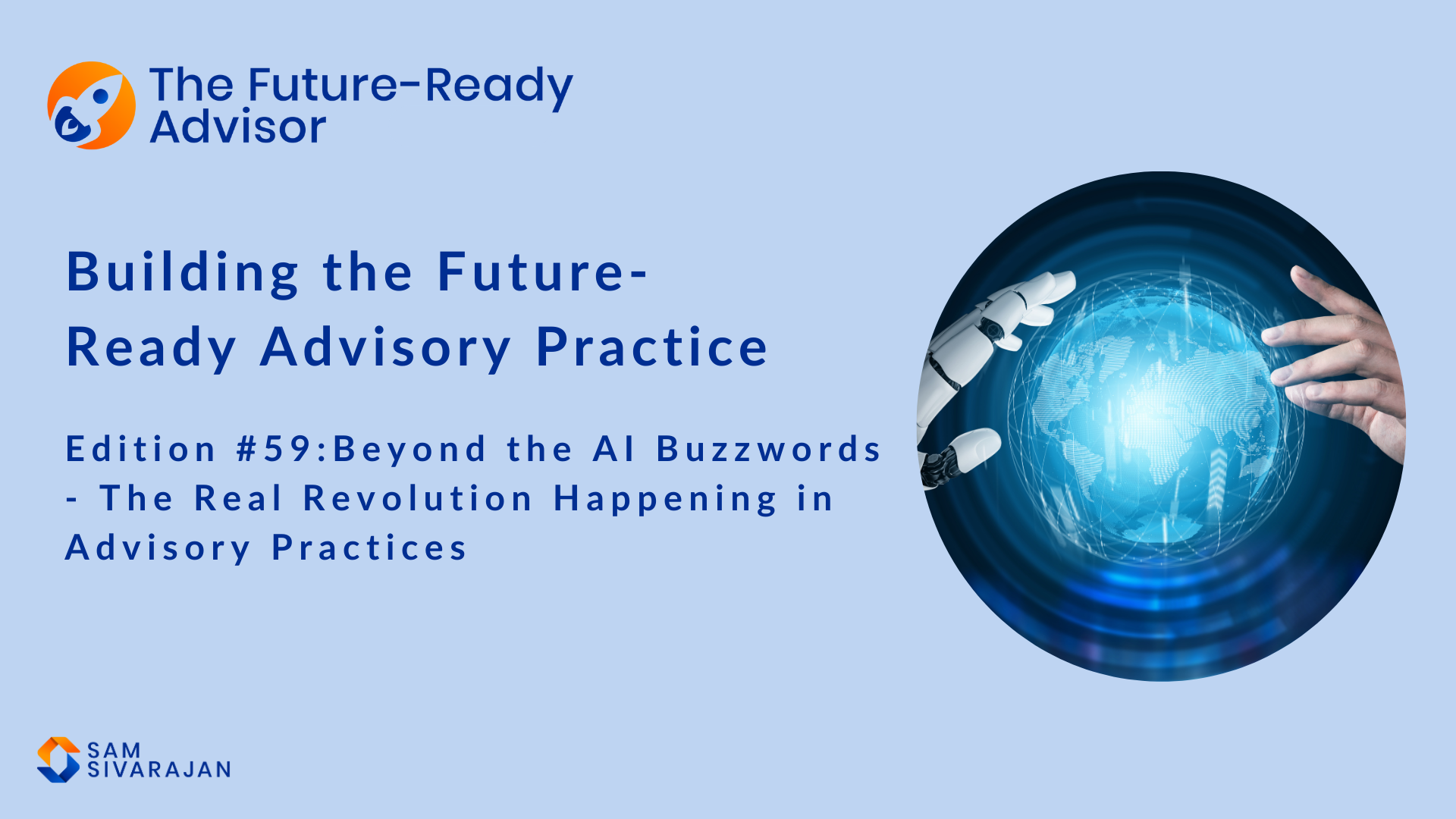Welcome to the 59th edition of #theFutureReadyAdvisor Newsletter!
Subscribe & join the conversation. Share comments and feedback.
Estimated reading time: 7 minutes
If you’ve attended any financial industry conference in the past year, you’ve likely witnessed the same scene: speakers making breathless proclamations about artificial intelligence transforming everything we do, followed by vendors showcasing AI-powered platforms that promise to revolutionize your practice. Yet, when advisors return to their offices, many struggle to translate this excitement into tangible improvements for their businesses and clients.
The disconnect is understandable. Between the utopian predictions of technology evangelists and the marketing claims of solution providers, it’s challenging to separate genuine innovation from cleverly packaged automation. As one advisor recently told me, “I don’t need another dashboard—I need to know which parts of my practice are truly ready for AI and which still require the human element that makes my service special.”
This advisor’s frustration echoes a sentiment I’ve encountered repeatedly in my conversations with wealth management professionals across the industry. The challenge isn’t awareness of AI’s potential—it’s distinguishing between what’s possible today versus what remains on the horizon, and then implementing practical solutions that deliver measurable value.
The Augmented Advisor: A Case Study in AI Implementation
Several years ago, I worked with a mid-sized wealth management firm that was drowning in operational tasks. Their team of highly credentialed advisors was spending nearly 30% of their time on administrative work—preparing for client meetings, generating basic reports, and responding to routine client inquiries. Their first instinct was to hire more support staff, but this would have significantly increased overhead without addressing the underlying inefficiency.
Instead, they implemented a targeted automation strategy focused on three specific applications: meeting preparation automation, natural language query capabilities for client portfolios, and an AI assistant for handling routine client emails. The results were transformative. Within six months, advisors reclaimed nearly 5-10 hours weekly—time they reinvested in deeper client conversations and strategic business development.
What made this implementation successful wasn’t cutting-edge technology but rather a methodical approach to identifying high-volume, repeatable tasks where AI could deliver immediate value while preserving the irreplaceable human elements of advice.

Where AI Actually Delivers Value Today
Despite the excitement around artificial intelligence, not all applications are equally mature or valuable. Based on my research and work with advisory firms, here are the three areas where AI is genuinely transforming practices today:
Client Communication Enhancement
Financial advisors devote about half of their working hours to direct client activities, yet less than 20% of their time is spent actually meeting with clients. The rest is absorbed by meeting preparation, planning analyses, and follow-up tasks. This time allocation highlights the persistent challenge of balancing client engagement with necessary but time-consuming administrative work. As Kitces Research notes, “the typical financial advisor only spends 50% of his/her time on direct client activity, and less than half of that is in the actual process of meeting with clients” (Kitces Research).
For example, one advisor I work with now spends 10 minutes dictating brief notes after client meetings, and her AI assistant transforms these into comprehensive meeting summaries and action items that previously took her 45 minutes to compile. The result is more consistent client communication without sacrificing the personal touch.
Knowledge Retrieval and Synthesis
AI-driven tools are transforming knowledge management in wealth management by enabling advisors to instantly access and synthesize information from vast data sources. According to Deloitte, AI empowers firms to “automatically research customer data and other data troves to help make effective decisions for their customers,” streamlining the process of preparing for client interactions and reducing the time spent searching across disparate systems (Deloitte).
This capability transforms how advisors prepare for client interactions. Rather than spending hours reviewing scattered notes and documents before an important meeting, advisors can ask natural language questions like “What are Sarah’s concerns about her estate plan?” or “Summarize our discussions about tax-loss harvesting over the past year,” receiving comprehensive answers in seconds.
However, it’s crucial to note that not all AI tools are created equal when it comes to handling sensitive client information. Advisors must carefully evaluate the data security and privacy protocols of any AI system processing confidential client data. Enterprise-grade solutions with proper security certifications, on-premises deployment options, and clear data retention policies should be prioritized over consumer-grade tools that may expose client information to third parties or use it for model training.
Data Analysis and Pattern Recognition
Artificial intelligence excels at analyzing large datasets to uncover patterns and insights that would otherwise go unnoticed. Deloitte’s research highlights that AI enables banks and wealth managers to provide better investment decisions, personalized client experiences, and improved operational efficiency. By leveraging predictive analytics and automation, firms can proactively identify client needs and opportunities, supporting both business growth and client retention (Deloitte).
Forward-thinking firms are using these capabilities to spot client opportunities, such as identifying accounts with excess cash during rising interest rate environments or flagging clients who might benefit from tax-loss harvesting based on market movements.
The key insight is that these applications don’t replace advisor judgment—they simply flag opportunities that might otherwise be overlooked in a sea of data. The human advisor still evaluates these insights and determines the appropriate action, bringing their expertise and client knowledge to bear.
What Remains Uniquely Human
For all its capabilities, AI still falls short in critical areas that constitute the core value of financial advice:
Understanding client values and goals: While AI can help organize information about client preferences, it cannot truly understand the emotional and psychological dimensions of a client’s relationship with money or how past experiences might still impact their present decisions.
Navigating complexity and ambiguity: Major life transitions—retirement, inheritance, business succession—involve nuanced trade-offs and emotional elements that require human wisdom and empathy.
Building genuine trust and rapport: The advisor-client relationship remains fundamentally human, built on shared experiences, values, and personal connection that technology cannot replicate.

A Framework for AI Implementation
For advisors looking to move beyond the hype and implement AI effectively, I recommend a simple three-step framework:
1. Task Audit: Catalog activities in your practice based on two dimensions: time required and uniqueness. Focus first on high-time, low-uniqueness tasks—those that are standardized but consume significant resources.
2. Augmentation vs. Automation: For each task, determine whether the goal is complete automation (for truly routine activities) or human augmentation (where AI supports but doesn’t replace human judgment).
3. Measured Implementation: Start with a single use case, measure results rigorously, and expand based on demonstrated value. Resist the temptation to transform everything at once.
The most successful implementations, of any technology, I’ve seen follow this measured approach, prioritizing practical applications that deliver immediate time savings while preserving the essential human elements that clients value most.
The Path Forward
AI won’t replace financial advisors, but advisors who effectively leverage AI will certainly replace those who don’t. The key is focusing on practical applications that enhance your unique value rather than chasing technology for its own sake.
The future belongs to the augmented advisor, or as I call it the Cyborg Advisor—professionals who maintain their essential human expertise and empathy while strategically deploying technology to eliminate friction, enhance capabilities, and deliver more value to clients. By focusing on practical, immediate applications rather than futuristic promises, you can position your practice to thrive amid technological change.
When you are ready, direct message me and I can help you with:
- Speaking Engagements & Workshops designed for your team and clients
- Tailored, high-impact Consulting and Coaching Services for your practice
Check out my podcast and other resources at www.samsivarajan.com
💡 Navigating AI uncertainty? Download my free “Uncertainty Advantage” guide and checklist to help you implement these AI applications with confidence, even when the technology landscape keeps shifting.
#theFutureReadyAdvisor #WealthManagement #AIinFinance


